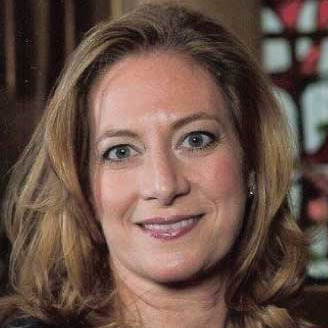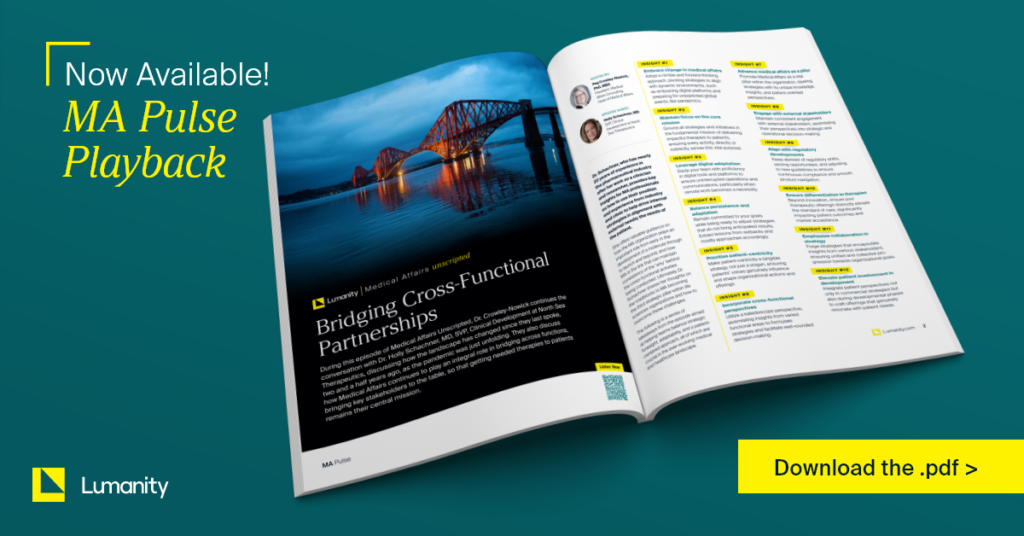Episode 12 of the Medical Affairs Unscripted podcast series recorded by Zipher, now part of Lumanity
During this episode of Medical Affairs Unscripted, Dr Crowley-Nowick continues the conversation with Dr Holly Schachner, MD, SVP, Clinical Development at North Sea Therapeutics, discussing how the landscape has changed since they last spoke, two and a half years ago, as the pandemic was just unfolding. They also discuss how Medical Affairs continues to play an integral role in bridging across functions, bringing key stakeholders to the table, so that getting needed therapies to patients remains their central mission.
Podcast Series: Medical Affairs Unscripted
Hosted by Dr Peggy Crowley-Nowick, in Medical Affairs Unscripted we explore a range of topics related to the strategic role of medical affairs from the perspective of industry experts. Through these conversations with our guests we will share first hand experience to provide the listener with insights and knowledge about the evolving role of medical affairs.
Podcast Transcript
Peg Crowley-Nowick 0:39
Welcome to the second season of Medical Affairs Unscripted. I’m your host, Peg Crowley-Nowick, president and founder of Zipher Medical Affairs, a full-service consulting firm. During this podcast, we’ll explore a range of topics related to the strategic role of Medical Affairs from the perspective of industry experts. Through these conversations with our guests, we will share firsthand experience to provide the listener with insights and knowledge about the evolving role of Medical Affairs. Please stay tuned at the end of the podcast to learn more about Zipher.
Today on Medical Affairs Unscripted, we’re going to have a slightly different type of podcast. We’re going to have a conversation with Holly Schachner, who was one of our first guests on this podcast just before the COVID pandemic. At that time, we discussed how Medical Affairs could move closer to being identified as a strategic pillar within the life sciences industry, equal to the research and development in commercial organizations. Today, we’re going to speak again with Holly and follow up on how the landscape has changed, what’s new in the industry and what hasn’t changed. We’re going to talk further about the mission of Medical Affairs. So, Holly, welcome.
Holly Schachner 2:07
Thank you very much, Peg. It’s very exciting to be back here. I can’t believe it’s been two and a half years, and, wow, so much has changed. And perhaps some things have not changed. So, I’m really looking forward to speaking with you today.
Peg Crowley-Nowick 2:25
Well, it’s been very interesting for us, we had a very successful opportunity to transition to a virtual world. Not that we ever planned on that. But we were able to make that transition, and certainly worked with a lot of companies that very quickly transitioned. Because of that, 2020 seemed fairly smooth after a while once companies started to realize what this would mean real challenge for companies who were getting ready for a launch or launching for the first time. But 2021 and 2022, I think have been transitional years. What does it mean, now? How do we move forward? And what does this look like? And from a Medical Affairs perspective, I know our clients are trying to understand what is new? What’s the same? And how should we approach our roles. So, I would love to hear from you what you think is the same and what might have changed.
Holly Schachner 3:27
Let’s sort of start with what hasn’t changed. In my mind. From my perspective, things that have not changed is the importance of the need for our pharmaceutical industry to bring meaningful therapies to patients who need them. And I think that what’s very intriguing to me about how some companies were able to very rapidly adapt to a digital remote world. And some companies perhaps were not. And I think that we were able to see that it can be done. And some of it needs to be, you know, how flexible is leadership? How well does leadership listen to the needs? And then how well does leadership and the functions across the company align to actually focus on what’s our true mission? Because the reality is, the true mission is not everybody needs to work in the same place. The true mission is getting needed therapies to patients. So how do we do that? And those companies that were able to be flexible and listen and be adaptive and focus on that real mission, I think have been very successful. They’ve been able to accomplish that mission. And you know, there are companies that probably haven’t. And they have stumbled but trying and stumbling is actually also part of the learning process as well. Not everything we do is going to be exactly right the first time.
Peg Crowley-Nowick 5:15
Absolutely. But the key there is remember the mission.
Holly Schachner 5:18
That’s right.
Peg Crowley-Nowick 5:19
And if you remember the mission, you can always change the tactics to accomplish that mission. But you have to stay focused on what you’re trying to do in order to be successful.
Holly Schachner 5:28
Absolutely.
Peg Crowley-Nowick 5:29
And putting the patient at the center of that and making sure that they have access to the right therapies is absolutely critical.
Holly Schachner 5:37
Yes.
Peg Crowley-Nowick 5:38
So, let’s talk about what does it take to make that happen? Our original conversation was a lot around Medical Affairs, and Medical Affairs as the third pillar in the pharmaceutical industry leading rather than supporting development and supporting commercial. Have you seen any changes in the scope of the role of Medical Affairs within the industry?
Holly Schachner 6:03
You know, changes that I have made, actually, over the past two and a half years have been in my roles, my roles have actually expanded more to a C suite role overseeing Medical Affairs, as well as clinical development leaning in across and really looking across different functions. And to me, it is absolutely critical for Medical Affairs, to lean in and have that voice. Learning from the external world, patients, payers, and clinicians. And bringing that into the company, so that it guides the strategy and guides the focus and shapes the focus, not even just guiding — shaping the focus of what decisions are going to be made, what studies are going to get done from a clinical development perspective, where does commercial need to look at their opportunities? It is so critically important. And I see that pillar needing to really step up and lead with their voice.
Peg Crowley-Nowick 7:29
So, there are two pieces that I hear within, within that statement that you’ve just made that the first is that they need to be a pillar. Medical Affairs needs to stand out and lead, and bring information and knowledge to the table, lean in, and deliver that. But the other piece that stands out that I think is probably even more vital today, within what you just said is you’ve included the patient, the payer, and the clinician, the patient was the first on your list. And I’m not sure two and a half years ago, I was hearing that as frequently as I am now. It’s almost as if the last couple of years have given everyone the opportunity to reset, and to remember what the mission is. And to elevate the patient, even from a corporate perspective of how you’re bringing in patient insights, and how you’re using those. You’re seeing that in development. You’re seeing that in Medical Affairs, and on the commercial side. I think it was more often on the commercial side in the past, but now it’s definitely a driving force. Do you think that that’s the last two years and people just had the time and the opportunity to rethink how they’re working? Or am I underestimating how the patient was engaged in what was in the process previously?
Holly Schachner 8:51
Well, number one, I want to thank you for being able to decipher and translate all the things that I said into really important points. And I’m not 100% sure of the answer, per se — Has it just been the two and a half years? Has it been something that’s been dangling in front of us, and the last two years really accelerated our understanding, and I think one could look from, you know, I look at vaccinations from COVID and the importance of different ways to prevent the pandemic, the science that we were learning from the pandemic. I think that we all got a very rapid understanding of all the questions that we can answer and all the questions that we can’t answer. And at the end of the day, what matters is the patient’s understanding of what’s going on. And that’s what’s going to help us get through and really work together. And perhaps that is something that has accelerated for those, perhaps, laggers or folks who didn’t necessarily always put the patient first. This really opened their eyes to say, we need to… This understanding from the patient perspective is really key to our education, our understanding, our movement forward.
Peg Crowley-Nowick 10:37
And I want to correct myself if it came off that I was saying that they didn’t always put the patient first. I think they always put the patient first but didn’t know how to really bring those insights from patients into the thought process of development or into the planning around Medical Affairs from an education perspective, or how the patient might feel about using a certain type of medicine or how it’s administered or the timing. It seems to me that it’s much more engaging now, and they’re bringing those insights to the table.
Holly Schachner 11:12
But yeah, I don’t believe you misspoke. And I actually think that what might have happened over the past two and a half years is that there’s been more definition and more understanding on what does patient-centric mean, what does patient engagement mean? And it’s not just a tag phrase, you know, it’s not tagline, it’s really about understanding the day in day out of a patient’s life, what would actually make something more convenient? It’s not what a survey said, it’s actually what do patients say? How can you show the differential benefit, so it’s really honing in and putting definition and meaning behind the words patient engagement and patient centricity?
Peg Crowley-Nowick 12:10
Excellent. That kind of leads into the discussion of cross-functional partners. When we’re talking about the patient, are we talking about the patient from Medical Affairs leading in that area? Are we talking about other cross-functional partners? What is the approach that you think works or that you believe in?
Holly Schachner 12:36
So, as of late, or I would say, one of the things that I hold near and dear, maybe as I get older, I understand myself a little bit better, perhaps. And I think of things as a kaleidoscope. And everybody’s sitting around the table, when you look at a kaleidoscope, through, one vision, one eye, it’s a very pretty picture. But when you turn the kaleidoscope and you look at it from a different perspective, a very different picture, still beautiful. But it’s not until you really complete and get all the perspectives that you fully understand the value of that. And to me, that’s the importance of cross-functional work — listening more than speaking, and really trying to understand the different perspectives. So, taking that and putting that towards the pharmaceutical biotech industry, having everybody at the table, and truly understanding what the patient perspective is. And I think having medical, being that voice of the patient, and ensuring that all the other functions, understand that, take that information and make their work better, more meaningful, more impactful, because they have heard that — that’s true partnership.
Peg Crowley-Nowick 14:12
Yeah, and that would make the difference, wouldn’t it? That makes Medical Affairs a pillar, and it brings the leadership to the table and allows everybody to partner and, and make it stronger rather than trying to, to push anybody out of the picture and not take seriously the leadership that can come from the knowledge that’s gained in the field and from the medical side of the organization. Thinking about bigger picture changes, maybe at a more macro perspective, what do you see coming? Or what… And I’m so glad I didn’t ask this before because there’s no chance I would have ever expected you to say, “I see a pandemic coming in the next couple of weeks and we will all be working from home for the next two years.” is like, I didn’t see that coming. But is there anything that you see coming that is going to shake up the industry again?
Holly Schachner 15:08
Oh, all right, let me go get my crystal ball. So it’s interesting because I think if we look globally, meaning outside the US, inside the US, financially, economically scientifically. There are a lot of smaller companies that are struggling. And I think that there are also a lot of small companies that are staying the course and staying afloat. And in my perspective, it’s those companies that are the most focused, the most collaborative, and bringing the most needed products to patients that are staying the course, that are actually doing well. And a lot of companies that perhaps are not focused, that are not bringing unique or differentiated therapies are unfortunately, not necessarily making it. That doesn’t mean that the work being done wasn’t good, doesn’t mean that people at those companies weren’t good, we have the best and the brightest in our industry around the world. But I think being focused, and being focused on bringing needed therapies to patients, is where we are going to be, and I will also add in there, the regulators are actually doing some unique things, allowing second advisory committees for neurodegenerative disease, allowing for indications based on secondary analyses, where primary analyses might not have quite cut it statistically, but clinically, were very meaningful. So, we’re seeing that recognition of patient needs, bringing truly differentiated, needed products to market. We’re seeing this collaboration globally, with regulators, with patients, with pharma companies. And I think that that’s a good thing. I don’t think any of us need additional “me, too” not differentiated, not really raising the bar therapies.
Peg Crowley-Nowick 17:54
It’s so hard, though, isn’t it? Because you’re given to the science that you’ve built up the science, the companies are working towards an approval from the very beginning thinking about what that’s going to look like, and everyone thinks that there’s differentiation until the studies get underway. And it’s hard to push aside the ones that aren’t differentiated — So that “go/no go” decision, and setting the bars in that decision-making for development is really important.
Holly Schachner 18:26
It is very important, and to me, it’s leaning in with the patient perspective, who’s that patient population? We need to also learn, we do a really good job of trying, “put more money towards it,” try again, “put more money towards it.” But we really need to put in “learn from things and pay attention to the patient.” And then try and do it a little better; It’s not about putting more dollars to it. And this is where the patient voice is so important because, in clinical development, if we have “Who is the patient who should get this treatment?” and “Who is the patient who should not get this treatment?” Clinical development should not be, “Let me put tons of money into a big 10-15,000 patient trial, I’ll have a big enough… and then I’ll get statistical significance and everybody will get this drug.” Don’t think that, that is what the future is. The future is — Tell me, who is this patient population? What is the true benefit they’re getting? What’s the true risk that we may see in this patient population and in each of these different, smaller groups… benefit risk, patient need…and bring that drug to market.
Peg Crowley-Nowick 19:56
Hence the reason that Medical Affairs has to play a role in development, and early, leaning in early.
Holly Schachner 20:03
Absolutely.
Peg Crowley-Nowick 20:05
Let’s talk for a couple of minutes about what it takes to launch today. And it’s I think it’s some similarities, just as we’ve said, there’s some differences. But you’ve recently been at a smaller company, you were in a couple of different organizations over the last few years, not just recently; so you have a perspective from large pharma to biotech. Thinking about that first launch for a team that’s together, and they’re working on their first launch — Where does Medical Affairs fit in the timing of that? How can they? How do you start planning and thinking, setting the urgency around what Medical Affairs has to do to get ready for launch? And I think it’s particularly important from the biotechs who are staying focused, who are planning to launch on their own? What does it look like for them?
Holly Schachner 21:01
Great question. And I’ve had some of these conversations in the past. And I have, you know, I don’t personally like to put a blanket timeline per se, because there are some companies who will say, oh, we need a Medical Affairs team 12 months before we launch, other people say 36 months before we launch. I think it’s all different, to be perfectly honest, it depends upon patient population, it depends upon how large the therapeutic area is, how are we going to be utilizing this treatment. So, numbers per se, in months don’t necessarily work. But I will say, for a lot of the smaller companies, you must have medical who is able to go and discuss and educate people on the science, the benefits, the risks, and the patient population who will most benefit from this. And I was actually reading, there was something on my LinkedIn thread yesterday — There was a notice on an HCPs door that said, “Sales reps are not welcome. Please call (this number) so that we can discuss if need be.” And I thought it was actually a very good thread because the person who posted it was a sales rep, he was a pharmaceutical rep, I should actually say and, he even said, “We don’t do sales. Our main job is to educate.” And I thought that that was a really nice perspective. And I actually feel that medical and our field based medical teams do a phenomenal job of educating. And they need to be out there to fully understand the therapeutic space, understand the thought leaders, and to understand who is seeing these patients. It’s not always the thought leaders who are seeing these patients. Where do these patients come in from? You know, I was involved with a phase two study on gastroparesis, that was fully designed by gastroenterologist, and I said, Where’s the input from the endocrinologist, they’re the ones who are seeing patients, even the primary care, Doc’s seeing a lot of patients with type two, perhaps with side effects like Astro priests, so you need to understand the patient and the disease state who’s seeing these people and be able to educate them. And that’s where Medical Affairs can take a huge, important role for launching because if the runway is nice and smooth the runway for education and to get people aware, and well educated and understanding the mechanisms of action, the benefits and the risks, then that launch is going to be so much more successful.
Peg Crowley-Nowick 24:26
Yeah, absolutely. I couldn’t agree more. And I like the concept of not talking about it in terms of time. Because each drug is a little bit different. The landscape is different. So as much as I talk about time because there’s nothing worse than getting called two months before the launch and asked what do we need to do now? It’s much nicer to come in 24 months ahead of time, think about building a team. Think about all the pieces, think about the communication tools and the narrative and how you want to educate what’s important to the people that you’ll be speaking to, what is the data that’s there, all of that is so critical. And that doesn’t come together in two months, even though within the company that people within the company know, all the information, the data, they know exactly what they were planning to do and how to do it. It’s still hard to organize a team and really execute on that from a launch perspective. It takes the whole village working together to have success. So, I liked that concept. And I do think that some things have changed. Because the amount of information, the number of virtual visits, the amount of knowledge that’s being shared, has, in my opinion, grown exponentially the amount of hours people are spending online. And how do you get through the noise? How do you get people to have that awareness and know it’s coming? So at least they can make decisions as to whether or not they have that patient population? Or if it’s right, for their patients? And it takes time?
Holly Schachner 25:58
Yeah, I agree with that. And I also think that, you know, while a lot of actual doors may be closed, I think the digital door has opened wide. And that creates a whole new opportunity. And it really takes a very skilled and knowledgeable person to understand and provide the right information at the right time for the person on the other side of that digital door.
Peg Crowley-Nowick 26:34
Absolutely. And I think people are less tolerant for information that they’re not interested in much quicker — If it doesn’t catch their interest right away, then they move around. And they totally control that. And I would say that that’s a positive…
Holly Schachner 26:48
Yes.
Peg Crowley-Nowick 26:48
…knowing all the information that comes my way. So, Holly, this has been a fantastic conversation. Have we missed any topics related to Medical Affairs or the industry that you were thinking about from the perspective of what’s happened in the last two years?
Holly Schachner 27:06
Yeah, and maybe I’m looking through things with some rose-colored glasses and recognizing that the past two and a half years have been incredibly challenging for many of us, but there are some silver linings. And if a silver lining is a bit more of a global perspective on how healthcare is delivered, and utilizing different tools like the digital tools that we have, innovation, and being a bit more open and understanding, you know, more sensitive to the needs of others, then I think that those are really good silver linings that will move us forward for healthcare.
Peg Crowley-Nowick 28:04
So, that’s a perfect way to end. I don’t even think I could summarize it any better, so I’m going to leave it at that. It’s been fantastic having a chance to talk with you, and I think that your ideas and perspectives on Medical Affairs will be very helpful to our listeners. So, thank you very much.
Holly Schachner 28:22
Thank you, Peg.

Episode guest
Holly Schachner, MD
SVP, Clinical Development at North Sea Therapeutics

“…and I think of things as a kaleidoscope … when you look at a kaleidoscope through one eye, it’s a very pretty picture, but when you turn the kaleidoscope and you look at it from a different perspective, very different picture, still beautiful, but it’s not until you really complete [it] and get all of the perspectives that you fully understand the value … that’s the importance of cross-functional work … having everybody at the table and truly understanding what the patient perspective is and I think having Medical [Affairs] being that voice of the patient and ensuring that all of the other functions understand that, take that information and make their work better, more meaningful … that’s true partnership.”
Dr Holly Schachner, MD












